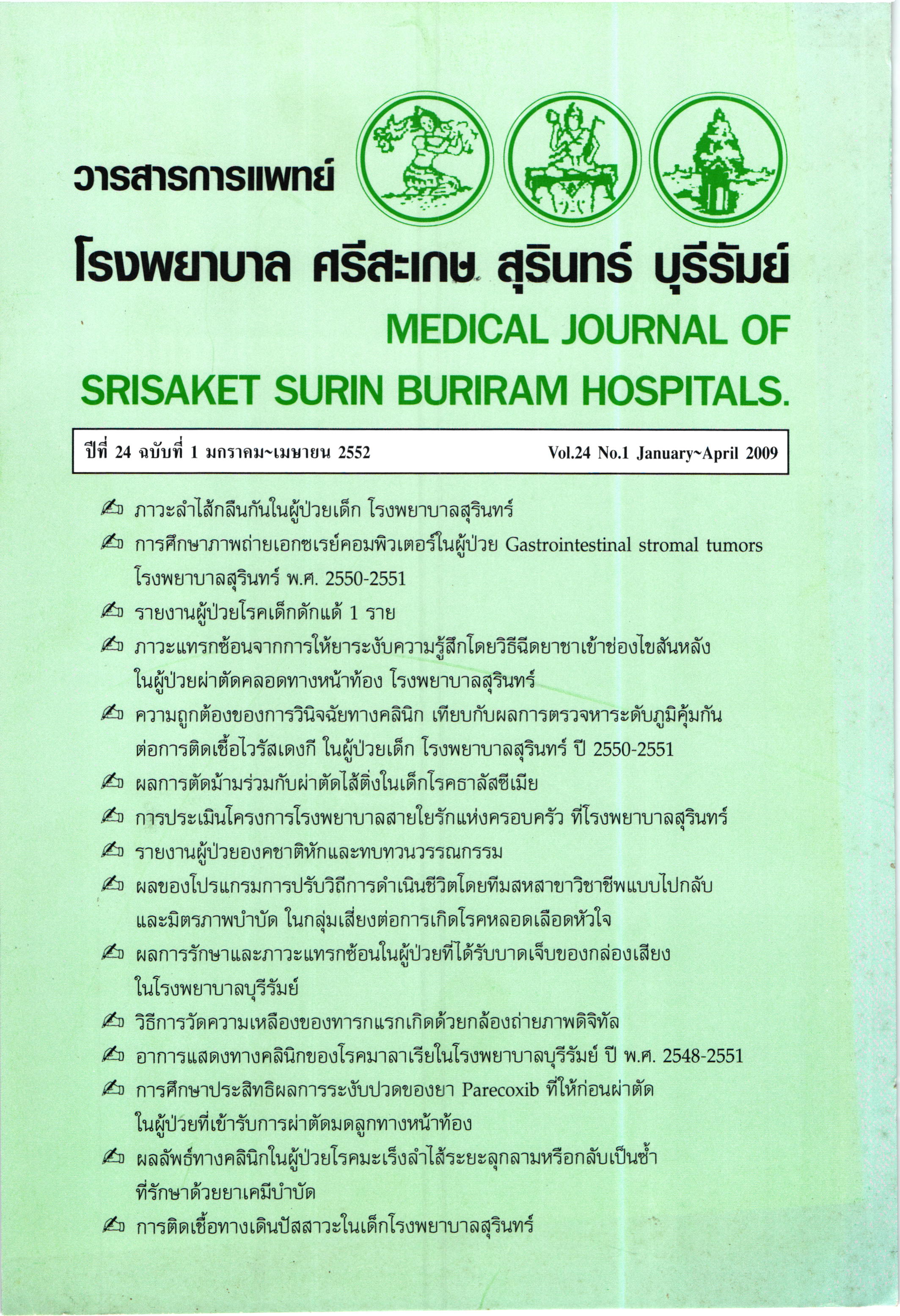รายงานผู้ป่วยโรคเด็กดักแด้ 1 ราย
Main Article Content
บทคัดย่อ
รายงานการติดตามผู้ป่วยเด็กชายเป็นบุตรคนที่สองของครอบครัวที่มีประวัติการแต่งงานในเครือญาติ แรกเกิดมีลักษณะเป็น colliodian baby ซึ่งลักษณะผิวหนังที่ผิดปกติทำให้เสี่ยงต่อปัญหาการ ควบคุมอุณหภูมิกาย การสูญเสียน้ำ และการติดเชื้อ การหายใจและการดูดนม ช่วงแรกเกิดได้รับการ รักษาประคับประคองที่ตึกผู้ป่วยหนักทารกแรกเกิด ต่อมาถุงหุ้มตัวลอกออก ผิวหนังมีสะเก็ดขนาดใหญ่ หนา สีเหลืองน้ำตาล บริเวณใบหน้าซีกบนพบสะเก็ดมากกว่า อาการปากปลิ้นหายไป อาการตาปลิ้นยังคงอยู่ ใบหูมีรูปร่างผิดปกติ มีสะเก็ดบนหนังศีรษะ จอตาปกติ ผิวหนังไม่มีเหงื่อออก ทนความร้อนไม่ได้ ลักษณะเข้าได้กับ LI ซึ่งเป็นโรคที่พบได้น้อยมาก (1:300,000) ได้ติดตามการรักษามาเป็นเวลากว่า 12 ปี ช่วงแรกได้เฉพาะผลิตภัณฑ์เพิ่มความชุ่มชื้นแก่ผิวหนัง และมารดาช่วยระบายความร้อนให้ผู้ป่วย ด้วย การทำถังน้ำสำหรับแช่ตัวระบายความร้อนหลังออกกำลังกายช่วง4 ปีหลังได้รับการรักษาด้วย Acitretin พบว่าตอบสนองต่อยาได้ดี สะเก็ดหนาตามตัวลดลงมาก ทนความร้อนได้ดีขึ้น
Article Details
เอกสารอ้างอิง
2. DiGiovanna JJ. Ichthyosiform dermatoses In: Latkowski JM, Freedberg IM, eds. Fitzpatrick’s dermatology in general medicine. 5th ed. New York : Mcgraw-Hill; 1999:581-603.
3. รัศนี อัครพันธุ์. Genodermatoses.tu: สุรเกียรติ อาชานุภาพ, ปรียา กุลละวนิชย์, ประวิตรพิศาลยบุตร และคณะ, บรรณาธิการ. ตำรา โรคผิวหนังในเวชปฏิบัติปัจจุบัน .(Dermatology 2010). กรุงเทพฯ : โฮลิสติก พับลิชชิ่ง; 2548:464-79.
4. Choate KA, Medalie DA, Morgan JR, et al. Corrective gene transfer in the human skin disorder lamellar ichthyosis. Nat Med 1996;2(11):1263-7.
5. Choate KA, Kinsella TM, Williams ML, et al. Transglutaminase 1 delivery to lamellar ichthyosis keratinocytes. Human Gene Therapy 1996;7(18):2247-53.
6. Parmentier L, Blanchet-Bardon C, Nguyen S, et al. Autosomal recessive lamellar ichthyosis : identification of a new mutation in transglutaminase 1 and evidence for genetic heterogeneity. Human Molecular Genetics 1995;4(8):1391-5.
7. Russel LJ, DiGiovanna JJ, Rogers GR, et al. Mutations in the gene for transglutaminase 1 in autosomal recessive lamellar ichthyosis. Nature Genetics 1995;9(3):279-83.
8. Candi E, Melino G, Lahm A, et al. Transgluminase 1 mutations in lamellar ichthyosis. Loss of activity due to failure of activation by proteolytic processing. Journal of Biological Chemistry 1998;273(22):13693-702.
9. พิชิต สุวรรณประกร. แนวทางในการตัดสินใจ รักษาโรคผิวหนัง. กรุงเทพฯ : ภาควิชาอายุรศาสตร์ คณะแพทยศาสตร์ จุฬาลงกรณ์ มหาวิทยาลัย; 2543:3-11.
10. Schorderet DF, Huber M, Laurini RN, et al. Prenatal diagnosis of lamellar ichthyosis by direct mutational analysis of the keratinocyte transglutaminase gene. Prenatal Diagnosis 1997;17(5):483-6.
11. Ozturk A, Caksen H, Cetin N, et al. A retrospective study on 16 colloidion babies. Turkish Journal of Pediatrics 1997;39(1):55-9.
12. Abdel-Magid EH, el-Awad Ahmed FR. Salicylate intoxication in an infant with ichthyosis transmitted through skin ointment-a case report. Pediatrics 1995; 95(3):456.
13. Ganemo A, Virtanen M, Vahlquist A. Improved topical treatment if lamellar ichthyosis : a double-blind study of four different cream formulations. British Journal of Dermatology 1999;141(6):1027-32.
14. พรทิพย์ ภูวบัณทิตสิน. Systemic retinoids. ใน: สุรเกียรติ อาชานุภาพ, ปรียา กุลละวนิชย์, ประวิตรพิศาลยบุตร และคณะ, บรรณาธิการ. ตำราโรคผิวหนังในเวชปฏิบัติปัจจุบัน (Dermatology 2010). กรุงเทพฯ: โฮลิสติก พับลิชชิ่ง; 2548: หน้า 730-8.
15. Bichakjian CK, Nair RP, Wu ww, et al. Prenatal exclusion of lamellar ichthyosis based on identification of two new mutations in the transglutaminase 1 gene. Journal of Investigative Dermatology 1998;110(2):179-82.
16. Suresh S, Vijayalakshmi R, Idrani S, et al. Short foot length: a diagnostic pointer for harlequin ichthyosis. Journal of Ultrasound in Medicine 2004;23(12):1653-7.
17. Choate KA, Khavari PA. Direct cutaneous gene delivery in a human genetic skin disease. Human Gene Therapy 1997;8(14):1659-65.


